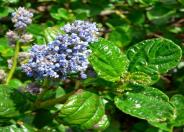
Common name:Carmel Creeper
Botanical name:Ceanothus griseus horizontalis
Carmel Creeper is one of the most popular forms of spreading shrubs. Its glossy oval leaves of 2" are bright green. The tiny, light blue flowers are abundant and form 1" clusters. This shrub benefits from pruning. It does best in well-drained soil with little to no summer water.

Common name:California Poppy, Golden Poppy
Botanical name:Eschscholzia californica
This small annual (sometimes acts as a perennial) plant will grow to less than 1' tall and has light, small blue green leaves with gold and orange flowers that bloom in spring and summer.

Common name:Blue Elderberry
Botanical name:Sambucus mexicana
The Blue Elderberry is a deciduous shrub that grows 4'-10' tall or tree that reaches up to 40' high. The leaves of this plant have 5-9 leaflets with white spring flower clusters developing into blue berries. The Blue Elderberry is a native to California, is drought tolerant and is a beneficial insect plant.

Common name:Blue Oat Grass
Botanical name:Helictotrichon sempervirens
The Blue Oat Grass is an evergreen, blue clumping grass that grows 12"-18" tall and wide. Its showy flowers are 1'-2' above the foliage. This plant looks good alone as well as in mass plantings. The blue oat grass likes dry hill sides and is drought tolerant.

Common name:John Dourley Manzanita
Botanical name:Arctostaphylos 'John Dourley'
This small, low growing shrub has grayish green leaves with pink and white flowers that bloom in winter and early spring.
Designer:
Photographer: GardenSoft
Practice grass-cycling by leaving short grass clippings on lawns after mowing, so that nutrients and organic matter are returned to the soil.
Develop healthy soil for plants that are vigorous and naturally pest-resistant.